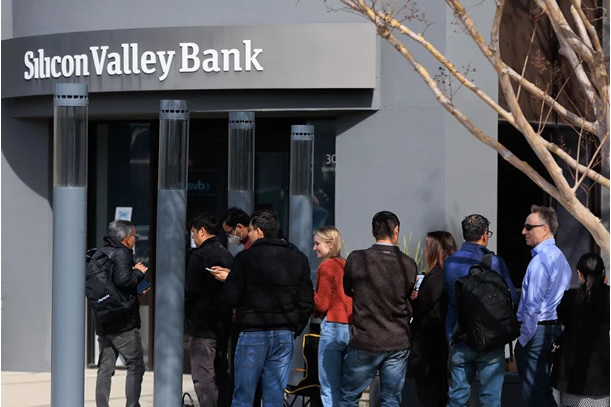Lessons from the SVB collapse

Feature Highlight
Comprehensive deposit insurance must also be part of the picture, and it is clearly better to have such a system in place before the fact.
Summary: Although Silicon Valley Bank was not deemed to be systemically important, its insolvency forced the US Federal Reserve to head off systemic contagion and exposed the inadequacy of the FDIC’s partial deposit insurance regime. The financial-stability framework adopted after the 2008 crisis obviously needs another overhaul.
Does Silicon Valley Bank’s collapse reveal a fundamental weakness in the current financial-stability framework, or does it merely point to a localised failure of supervision?
By jeopardizing many prominent, high-growth companies in the tech sector, the bank’s failure certainly put significant political pressure on the US Federal Reserve. But the Fed’s emergency weekend intervention – when it provided a comprehensive deposit guarantee and extended loans to other banks, valuing their collateral of US Treasury bonds at par – suggests that it was genuinely concerned about financial contagion, too. And now, the recent scare around Credit Suisse has forced European banking regulators to mull the same questions.
Obviously, there was a failure of supervision. SVB’s insolvency came about because of its entirely foreseeable exposure to rising interest rates. It had used customer deposits to fund investments in a portfolio of US Treasuries that were poised to decline in value when the Fed started tightening its monetary policy a year ago. The problem was neither credit risk nor liquidity risk; rather, it was an obvious form of market risk. The Fed’s usual stress tests might have spared supervisors the embarrassment, except that SVB was exempted from this requirement, owing to a 2018 legislative change that increased the threshold for participation from $50 billion in assets to $250 billion. SVB had $209 billion in assets when it failed.
This gap suggests that there may indeed be a deeper problem with the financial-stability framework. Since the 2008 global financial crisis, regulators on both sides of the Atlantic have attempted to strengthen financial-sector regulation and supervision within the confines of a broadly consistent framework. The two key features are enhanced supervisory powers and capabilities, with a particular focus on institutions identified as being “systemically significant” and partial deposit-insurance schemes, which are designed to protect deposits up to a certain amount per depositor.
SVB was not deemed systemically important. Yet not only was the Fed forced to mount an extraordinary emergency intervention to head off systemic risks introduced by its collapse. It also effectively acknowledged that the FDIC’s partial deposit insurance regime (alongside new rules on bank resolution) was inadequate for reassuring depositors; nothing less than comprehensive deposit insurance would do. Given that these conclusions were reached after the fact, it is worth asking whether we ever would have come to them in the absence of a sudden crisis.
Of course, the “systemic importance” logic of the post-2008 regime may have had more to do with the difficulty of unwinding massive institutions like Lehman Brothers than with concerns about their greater propensity to cause crises. After all, financial crises can start with institutions of all sizes, and one of the areas where there has been the most progress since the financial crisis has been in establishing more detailed and robust rules for bank resolution.
But the SVB saga suggests that the post-2008 reforms – strengthening capital-adequacy requirements, establishing rules for bank resolution (with bail-ins for bondholders), drawing up “living wills” for banks – were not enough. Comprehensive deposit insurance must also be part of the picture, and it is clearly better to have such a system in place before the fact.
To be sure, it looks as though the Fed’s intervention was primarily motivated by a concern about financial contagion, rather than by the need to protect corporate depositors in a strategically important sector. But in the case of SVB’s subsidiary in the United Kingdom, the reverse appears to be true. Although no taxpayer money was spent to rescue depositors (SVB UK was purchased by HSBC for £1), one still might ask whether this is the best way to implement an industrial policy or to protect a critical sector.
In the case of the United States, we have witnessed yet another episode in which the central bank has been called upon to use its balance sheet to protect the financial system. Although the crises of the last decade may have had different origins, the central bank fix has been similar. In all cases, the government is effectively acting as the insurer of last resort.
This may be inevitable, and even desirable, in the sense that it provides the public good of financial stability. But the government’s expanded role forces us to ask whether it would not be more efficient to bypass the banks altogether by allowing depositors – both retail and corporate – to keep their funds at the central bank, through the issuance of a central bank digital currency. That would be a comprehensive form of deposit insurance ex ante.
More broadly, if some sectors of the economy are going to be protected no matter what, we should establish a framework for doing that ahead of time, rather than bailing out uninsured depositors after the fact. These are among the most important lessons that policymakers should take from this latest crisis.
Lucrezia Reichlin, a former director of research at the European Central Bank, is Professor of Economics at the London Business School and a trustee of the International Financial Reporting Standards Foundation. Copyright: Project Syndicate.
Other Features
-
Got excess airtime? Discover the Top 5 Best Platforms to sell ...
Prestmit is one of the leading airtime-to-cash platforms in Nigeria, known for its speed and reliability.
-
-
Trump is losing his geoeconomic war
The Trump administration has reached for the most obvious and widely discussed lever: the dollar.
-
Lessons from Lesotho for low-income countries
For years, global development practitioners have been trapped in a false choice of aid versus trade. Lesotho tried ...
-
Unlocking opportunity: Why mobility is key to Nigeria’s prosperity
Transforming mobility in Nigeria requires a collective, system-wide approach from key stakeholders across the entire ...
-
5 best virtual cards for Apple Music subscription in Nigeria
Discover the 5 best virtual cards for Apple Music in Nigeria: Cardtonic, Tribapay, Klasha, Vesti, and SnappyPay, ...
-
Unlocking opportunity: How poultry can catalyse prosperity in Nigeria
According to a recent survey, 45% of Nigerians – equivalent to 92.7 million people – do not consume ...
-
How the ISA 2025 reshapes Nigeria’s crowdfunding regulation
The Investment and Securities Act 2025 expands the SEC’s oversight functions, mandates the registration of all ...
-
The tragedy of Emmanuel Macron
The contrast between Macron’s early promise and his current image seems almost theatrical.
Most Popular News
- NDIC pledges support towards financial system stability
- Artificial intelligence can help to reduce youth unemployment in Africa – ...
- Women innovation, entrepreneurship conference sets to hold in Cape Town
- Italy’s largest union brings 200,000 to Rome for work, democracy protest
- AFC-backed Infinity Power achieves financial close on 200MW wind farm
- George Elombi takes over as Afreximbank’s fourth President















